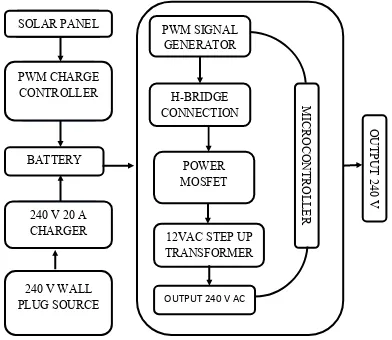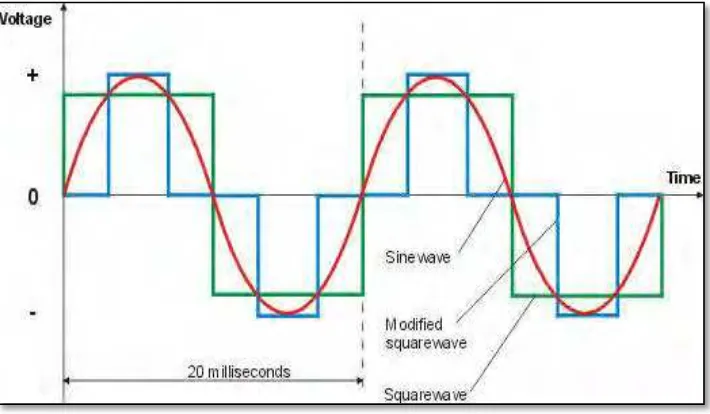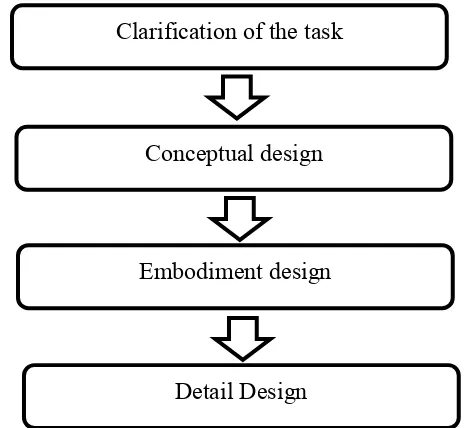DESIGN FOR MANUFACTURING OF PORTABLE POWER SUPPLY HOUSING PROTOTYPE
NORISAM BIN AHMAD SAIDI
SUPERVISOR DECLARATION
“I hereby declare that I have read this thesis and in my opinion this thesis is sufficient in terms of scope and quality for the award of the degree of
Bachelor of Mechanical Engineering (Automotive)”
Signature: ...
DESIGN FOR MANUFACTURING OF PORTABLE POWER SUPPLY HOUSING PROTOTYPE
NORISAM BIN AHMAD SAIDI
This thesis is submitted in accordance with requirement for the Bachelor of Mechanical Engineering (Automotive) (Hons.)
Faculty of Mechanical Engineering Universiti Teknikal Malaysia Melaka
DECLARATION
“I hereby declare that the work in this thesis is my own except for summaries and quotations which have been duly acknowledged.”
Signature: ...
iii
DEDICATION
This thesis is dedicated
for
Dearest Dad and Mom
Ahmad Saidi bin Jamaludin and Nor Fauziah binti Osman
ACKNOWLEDGEMENT
Alhamdulillah, thanks to Allah s.w.t, I have run my project of Sarjana Muda for completing my studying at UTeM and I gained invaluable experiences during the project execution.
Special thanks are dedicated to my supervisor, Dr. Mohd Azman Bin Abdullah and also co-supervisor Dr. Faiz Redza Bin Ramli for giving full faith on me to carry on this project. Beside that’s, thanks for always giving me support, guidance, instruction and endless help on this project.
I also would like to thank my whole family member that give me the support and advice. They are very helping to give moral value to run this project properly.
v
ABTRACT
ABSTRAK
vii
TABLE OF CONTENT
CHAPTER TITLE PAGE
DECLARATION ii
ACKNOWLEDGEMENT iii
ABSTRACT iv
ABSTRAK v
TABLE OF CONTENT vi
LIST OF TABLES viii
LIST OF FIGURES ix
LIST OF UNITS x
LIST OF ABBREVIATION xi
LIST OF APPENDICES xii
1 INTRODUCTION 1
1.1 Background 1
1.2 Problem Statement 2
1.3 Objectives 3
1.4 Scope 3
1.5 Thesis Outline 3
2 LITERATURE REVIEW 4
2.0 Introduction 4
2.1 The Portable Power Supply System 4
2.2 Design Process 7
2.2.1 History and evolution of design goal 7
2.2.3 Design phases 9 2.3 Acrylonitrile Butadiene Styrene (ABS) 10
2.4 Polylactic Acid (PLA) 11
3 METHODOLOGY 13
3.0 Introduction 13
3.1 Design the Housing 14
3.1.1 Parts Assembly 16
3.1.2 Design the housing 18
3.2 3D Printing 20
3.3 Decision Matrix 21
4 RESULTS AND DISCUSSIONS 23
4.0 Introduction 23
4.1 Material Selection 23
4.2 Design Selection 25
4.3 Design improvement 28
4.4 Analysis of the Design 29
4.4.1 ABS Plastic 29
4.4.2 PVC 31
4.5 Fabrication of the Prototype 32
5 CONCLUSION AND RECOMMENDATION 34
5.1 Conclusion 34
5.2 Recommendation 35
REFERENCES 36
ix
LIST OF TABLES
NO. TITLE PAGE
3.1 List of parts with its dimension 15
3.2 Dimension of housing for each design 18
3.3 Weighted decision matrix 21
3.4 Decision matrix to select design 22
4.1 Data for each criteria of the material 24 4.2 Score of the criteria and total marks 24
4.3 Data for each criteria 26
LIST OF FIGURES
NO. TITLE PAGE
2.1 The basic system of the portable power supply 5 2.2 The overall process of the portable power supply 5
2.3 Graph of voltage against time 6
2.4 The main phases of the design process 9
3.1 Flowchart for conceptual design 14
3.2 Assembly drawing 1 16
3.3 Assembly drawing 2 17
3.4 Assembly drawing 3 17
3.5 Design 1 18
3.6 Design 2 19
3.7 Design 3 19
4.1 Analysis for Design 1 25
4.2 Analysis for Design 2 25
4.3 Analysis for Design 3 25
4.4 The new design 27
xi
LIST OF UNITS
Pa = Pascal s = seconds % = percent kg = kilogram
RM = Ringgit Malaysia cm = centimetre cm3 = centimetre cube
kg/m2 = kilogram per meter square kg/m3 = kilogram per meter cube Amp = Ampere
LIST OF ABBREVIATION
UTeM = Universiti Teknikal Malaysia Melaka DC = Direct current
AC = Alternative current
SMPS = Switch Modulus Power Supply
CATIA = Computer Aided Three-Dimensional Interactive Application TNB = Tenaga Nasional Berhad
US = United Stated
EPA = Envinronmental Protection Agency ABS = Acrylonitrile Butadiene Styrene PLA = Polylactic Acid
xiii
LIST OF APPENDICES
NO. TITLE PAGE
A Mendelmax 3D Printer 37
B Final Prototype of the Design 38
C Gantt chart PSM 1 39
D Gantt chart PSM 2 40
E All view drafting of the design 41
CHAPTER 1
INTRODUCTION
1.1 BACKGROUND
Portable power supply is a device that can produce an amount of power to be used. It is a device which can store some amount of power and can release the power whenever it is needed. The concept of this portable power supply is likely similar to the rechargeable battery, which can absorb and store some amount of power and then release it to be used but the different is that this portable power supply can store and produce even more power compared to the rechargeable battery. Because of the technology becomes even more advanced, the usage of gadget such as smartphone, tablet and play station portable extremely increased. These all things use battery for their power source and the battery needs to be recharged frequently. That is why the request for the portable power supply typically for gadget, lately is becoming a trending but this portable power supply can only support low-power device.
2
There are so many advantage of this device that can help people to solve their problem. It can help people in their daily life. It can also can be carried anywhere as it is portable and not too big in size. The portable power supply can be used with multipurpose function at one time. This is because the device consist of two sockets and five USB sockets. It can charge many devices at one time and use other appliances at the same time. This portable power supply was designed and developed to solve problems such as power supply shortage, outdoor instance usage and power loss due to flood.
1.2 PROBLEM STATEMENT
Lately, Malaysia had an unstable weather where the weather always changes. In the earlier days, there were always hot day and no rain, now at the end of this year, it is always raining and sometimes there were some strong wind. This situation can bring to electric shortage due to flood of due to the main cable cut-off. During this era, electric is a power source that people really depending on. People will lose their source of light in the night and felt hot because of fan or air-conditioner not functioning.
Next, another problem is at the night market. Many sellers are using generator as their source of power to support their electrical appliances such as light. The generator use fuel as their source of power. It requires extra money when using generator. Not to mention about its noise when the generator is running. It is also big in size and really heavy to carry anywhere.
1.3 OBJECTIVES
The objective of this project is to design the housing for the portable power supply. The second objective is to analyse the different materials for the prototype. The last objective is to fabricate the prototype of the design using the selected material.
1.4 SCOPE
The first scope of the project is to developing three design of portable power supply housing using CATIA software. Next is to choose the best material that will be used for the analysis of the prototype. The next scope is to select the best design based on the data of the material and lastly is to fabricate the prototype of the housing using the selected design and material.
1.5 THESIS OUTLINE
4
CHAPTER 2
LITERATURE REVIEW
2.0 INTRODUCTION
Literature review is the gathering of information from previous research or project. The information can be obtained from referring journal, article or information from reliable websites. The purpose is to help understanding this research more in order to answer the objective of the study.
2.1 THE PORTABLE POWER SUPPLY SYSTEM
The basic systems of the portable power supply not explain detail about the process. So here is the detail process of the device which is explain the cycle of the process. According to Figure 2.2, battery will accept power from two sources and that is from the 240 V wall plug source and from the solar panel.
Inverter Charging
source
Storage
(Battery) frequency High-oscillator, transformer,
rectifier, filter
Power
stage AC
[image:20.595.105.505.66.232.2]out
Figure 2.1: The basic system of the portable power supply
SOLAR PANEL 240V WALL PLUG SOURCE PWM CHARGE CONTROLLER 240V 20A CHARGER BATTERY PWM SIGNAL GENERATOR H-BRIDGE CONNECTION POWER MOSFET
12VAC STEP UP TRANSFORMER M IC R OCON TRO LL ER
OUTPUT 240 V AC
OU
TPUT 240 V
SOLAR PANEL
240 V WALL PLUG SOURCE PWM CHARGE CONTROLLER
240 V 20 A CHARGER
[image:20.595.98.490.358.698.2]6
[image:21.595.159.514.332.539.2]Before it arrives at the battery, it pass through 240 V 20 Amp charger and PWM solar controller for the power from the solar panel. Next, from the battery it will pass to the power inverter. The process in the power inverter works in cycle. Figure 2.3 shows the cycle in the graph of voltage against time. As can be seen, the red waveform is a pure sine wave, blue is a modified sine wave, and green is a square wave. The specified period (20 ms) would vary based on desired frequency. First, the microcontroller will receive the signal and pass to the PWM signal generator. Then it will pass through the H-bridge connection and power mosfet and arrived at the step up transformer. The transformer is the last component and 240 V AC is produce. The 240 V A.C that is produced is not the same as 240 V AC that is supplied from the wall plug that T.N.B provided. This is because the A.C that is produced is Modified Sine Wave which is varying from the Pure Sine Wave from the wall outlet socket.
2.2 DESIGN PROCESS
Design can have many different definitions. Most generally, “design” is a process for deliberately creating a product to meet a set of needs. Mobile applications development requires both engineering design and product design. Engineering design focuses on physics, such as speed, mass and other performance measures while product design also considers user and consumers by asking what the user wants in a product.
To have a great design, it needs to have creativity. Creativity requires large amounts of ideas, flexibility of ideas and originality. It is important not to focus on practicality only when generating ideas. Doing so would impede the flow of ideas and impractical ideas often point toward a more practical options. Common problems that occur when brainstorming include using the first idea that pops up, inadequate competitive review, not involving entire team in process and missing potentially strong solutions.
2.2.1 History and evolution of design goal
8
Recent legislation from the US Environmental Protection Agency (EPA) has prompted companies to project Design for Environmental Friendliness or Green Design as an important product design goal (Billatos and Nevrekar, 1994). Ford Motor Company recently set up a facility for disassembling used cars and selling used parts, profitability of which will depend upon designing products for disassembly (Wall Street Journal, 1999). Simultaneous optimization of a number of design goals (Design for ``X’’) where X could stand for assembly, manufacturability, safety, reliability or any of the other design goals, is the latest in the research agenda (Ullman, 1997). While all these different design goals have gained recognition and acceptance, product performance or what is broadly known as product functionality, as a design goal, has often been taken for granted by designers. Indeed, the provision of functionality in a product is the purpose of design. It is possible that even though product functionality may have been an important initial product design goal for designers, the necessity to accord other design goals like safety, usability and quality to a higher priority may have relegated the task of ensuring functionality in the prototype to a relatively lower priority.
2.2.2 Ways to innovate
2.2.3 Design phases
[image:24.595.186.418.148.362.2]The four main phases of the design process are shown in Figure 2.4 below.
Figure 2.4: The main phases of the design process (Glegg, 1969)
Clarification of the task is the starting point for the design process which is an idea or a market need, often stated in vague (Pahl and Springer, 1996). Before subsequent design phases start, it is important to clarify the task by identifying the true requirement and constraints. The result of this phase is a design specification which is a key working document that should be continually reviewed and updated as the design develops. Then, the real need is need to identify. Identify real need is to avoid solving the wrong problem which is wise to spend some time identifying the true needs and preparing a clear solution. This can avoids any indication of how the problem should be solved. A useful technique is to systematically raise the level of abstraction.
Next is the conceptual design. In this phases, concepts with the potential of fulfilling the requirements listed in the design specification must be generated (Pahl and Springer, 1996). The overall functional and physical relationships must be considered and combined with preliminary embodiment features. The result of this phase is concept drawing. The first step in conceptual design is to identify the overall function (Glegg,
Clarification of the task
Conceptual design
Embodiment design


